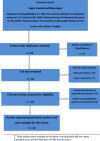Evidence that a tax on sugar sweetened beverages reduces the obesity rate: a meta-analysis
- PMID: 24225016
- PMCID: PMC3840583
- DOI: 10.1186/1471-2458-13-1072
Evidence that a tax on sugar sweetened beverages reduces the obesity rate: a meta-analysis
Abstract
Background: Excess intake of sugar sweetened beverages (SSBs) has been shown to result in weight gain. To address the growing epidemic of obesity, one option is to combine programmes that target individual behaviour change with a fiscal policy such as excise tax on SSBs. This study evaluates the literature on SSB taxes or price increases, and their potential impact on consumption levels, obesity, overweight and body mass index (BMI). The possibility of switching to alternative drinks is also considered.
Methods: The following databases were used: Pubmed/Medline, The Cochrane Database of Systematic Reviews, Google Scholar, Econlit, National Bureau of Economics Research (NBER), Research Papers in Economics (RePEc). Articles published between January 2000 and January 2013, which reported changes in diet or BMI, overweight and/or obesity due to a tax on, or price change of, SSBs were included.
Results: Nine articles met the criteria for the meta-analysis. Six were from the USA and one each from Mexico, Brazil and France. All showed negative own-price elasticity, which means that higher prices are associated with a lower demand for SSBs. Pooled own price-elasticity was -1.299 (95% CI: -1.089 - -1.509). Four articles reported cross-price elasticities, three from the USA and one from Mexico; higher prices for SSBs were associated with an increased demand for alternative beverages such as fruit juice (0.388, 95% CI: 0.009 - 0.767) and milk (0.129, 95% CI: -0.085 - 0.342), and a reduced demand for diet drinks (-0.423, 95% CI: -0.628 - -1.219). Six articles from the USA showed that a higher price could also lead to a decrease in BMI, and decrease the prevalence of overweight and obesity.
Conclusions: Taxing SSBs may reduce obesity. Future research should estimate price elasticities in low- and middle-income countries and identify potential health gains and the wider impact on jobs, monetary savings to the health sector, implementation costs and government revenue. Context-specific cost-effectiveness studies would allow policy makers to weigh these factors.
Figures
References
-
- World Health Organization. Report of a Joint WHO/FAO Report. Diet, Nutrition and the Prevention of Chronic Diseases. Geneva: WHO technical report; 2002. - PubMed
-
- James WPT. WHO recognition of the global obesity epidemic. Int J Obes (Lond) 2008;32(S7):S120–S126. - PubMed
-
- Malik VS, Willett WC, Hu FB. Global obesity: trends, risk factors and policy implications. Nat Rev Endocrinol. 2013;9(1):13–27. - PubMed
Publication types
MeSH terms
LinkOut - more resources
Full Text Sources
Other Literature Sources
Medical
Miscellaneous



